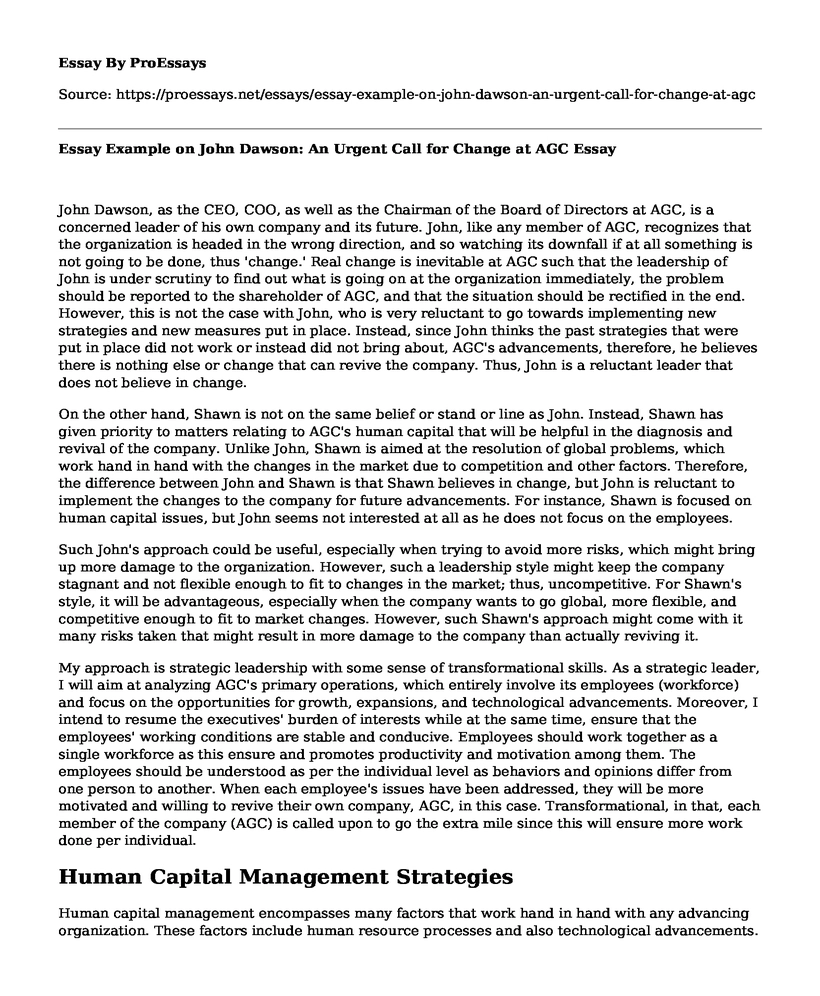John Dawson, as the CEO, COO, as well as the Chairman of the Board of Directors at AGC, is a concerned leader of his own company and its future. John, like any member of AGC, recognizes that the organization is headed in the wrong direction, and so watching its downfall if at all something is not going to be done, thus 'change.' Real change is inevitable at AGC such that the leadership of John is under scrutiny to find out what is going on at the organization immediately, the problem should be reported to the shareholder of AGC, and that the situation should be rectified in the end. However, this is not the case with John, who is very reluctant to go towards implementing new strategies and new measures put in place. Instead, since John thinks the past strategies that were put in place did not work or instead did not bring about, AGC's advancements, therefore, he believes there is nothing else or change that can revive the company. Thus, John is a reluctant leader that does not believe in change.
On the other hand, Shawn is not on the same belief or stand or line as John. Instead, Shawn has given priority to matters relating to AGC's human capital that will be helpful in the diagnosis and revival of the company. Unlike John, Shawn is aimed at the resolution of global problems, which work hand in hand with the changes in the market due to competition and other factors. Therefore, the difference between John and Shawn is that Shawn believes in change, but John is reluctant to implement the changes to the company for future advancements. For instance, Shawn is focused on human capital issues, but John seems not interested at all as he does not focus on the employees.
Such John's approach could be useful, especially when trying to avoid more risks, which might bring up more damage to the organization. However, such a leadership style might keep the company stagnant and not flexible enough to fit to changes in the market; thus, uncompetitive. For Shawn's style, it will be advantageous, especially when the company wants to go global, more flexible, and competitive enough to fit to market changes. However, such Shawn's approach might come with it many risks taken that might result in more damage to the company than actually reviving it.
My approach is strategic leadership with some sense of transformational skills. As a strategic leader, I will aim at analyzing AGC's primary operations, which entirely involve its employees (workforce) and focus on the opportunities for growth, expansions, and technological advancements. Moreover, I intend to resume the executives' burden of interests while at the same time, ensure that the employees' working conditions are stable and conducive. Employees should work together as a single workforce as this ensure and promotes productivity and motivation among them. The employees should be understood as per the individual level as behaviors and opinions differ from one person to another. When each employee's issues have been addressed, they will be more motivated and willing to revive their own company, AGC, in this case. Transformational, in that, each member of the company (AGC) is called upon to go the extra mile since this will ensure more work done per individual.
Human Capital Management Strategies
Human capital management encompasses many factors that work hand in hand with any advancing organization. These factors include human resource processes and also technological advancements. The following strategies are, therefore recommended.
- Human resource management (HRM).
- Administration of benefits.
- Managing talents and performance.
- Managing time and labor.
- Onboarding.
- Recruitments and keeping track of applicants & employees.
- Evaluation of employees' payroll.
For instance, many organizations from the US and across the globe are now realizing how advantageous and beneficial "going global" is as it involves lots of financial benefits. For example, global trade for some countries varies from just 5% to about 10% of their GDP to above 100%, for instance, in Singapore.
References
Bass, B. M., & Stogdill, R. M. (1990). Bass & Stogdill's handbook of leadership: Theory, research, and managerial applications. Simon and Schuster.
Going Global 101: What Does It Mean to "Go Global"?. Lionbridge. (2020). Retrieved 20 April 2020, from https://www.lionbridge.com/blog/translation-localization/going-global-101-what-does-it-mean/.
Sutcliffe, W. (2006). Managing the unexpected: Assuring high performance in an age of complexity. John Wiley & Sons.
The 6 dimensions model of national culture by Geert Hofstede. Geert Hofstede. (2020). Retrieved 20 April 2020, from https://geerthofstede.com/culture-geert-hofstede-gert-jan-hofstede/6d-model-of-national-culture/.
Cite this page
Essay Example on John Dawson: An Urgent Call for Change at AGC. (2023, May 29). Retrieved from https://proessays.net/essays/essay-example-on-john-dawson-an-urgent-call-for-change-at-agc
If you are the original author of this essay and no longer wish to have it published on the ProEssays website, please click below to request its removal:
- A Reflection on Effective Communication and Leadership Essay
- Business Analytics: Coffee House Industry Paper Example
- Ageism in the Health Sector Paper Example
- Essay on Leaders: Essential Skills for Navigating Change, Problem-Solving, and Decision-Making
- New Balance: Understanding Consumer Decision-Making Process - Essay Sample
- Essay Example on Ez-Pleeze Strategic Plan, SWOT Analysis & Strategic Recommendation
- Paper Example on Integrity and Humility: A Nurse Leader's Core Values







